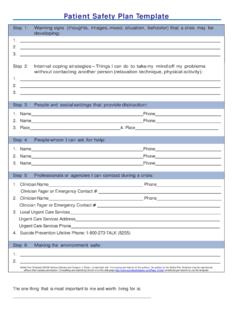Transcription of Navy John Lewis (TAO-205) Class Oiler Shipbuilding Program …
1 Navy John Lewis (TAO-205) Class Oiler Shipbuilding Program : Background and Issues for Congress Ronald O'Rourke Specialist in Naval Affairs Updated October 22, 2018 Congressional Research Service 7-5700 R43546 Navy John Lewis (TAO-205) Class Oiler Shipbuilding Program Congressional Research Service Summary The John Lewis (TAO-205) Class Oiler Shipbuilding Program , previously known as the TAO(X) Program , is a Program to build a new Class of 20 fleet oilers for the Navy. The primary role of Navy fleet oilers is to transfer fuel to Navy surface ships that are operating at sea, so as to extend the operating endurance of these surface ships and their embarked aircraft. The first ship in the TAO-205 Program was funded in FY2016. The second was funded in FY2018. The Navy s proposed FY2019 budget requests the procurement of the third and fourth ships in the Program . The Navy estimates the combined procurement cost of the two ships at $1, million, or an average of $ million each.
2 The two ships have received $ million in prior-year advance procurement (AP) funding, and the Navy s proposed FY2019 budget requests the remaining $ million in procurement funding needed to complete the two ships estimated combined procurement cost. The Navy s proposed FY2019 budget also requests $ million in AP funding for TAO-205s to be procured in future fiscal years, and $ million in cost-to-complete procurement funding to cover cost growth on TAO-205s procured in prior fiscal years, bringing the total FY2019 procurement funding request for the TAO-205 Program (aside from outfitting and postdelivery costs) to $1, million. The Navy was granted authority for using a block buy contract for procuring the first six TAO-205s by Section 127 of the FY2016 National Defense Authorization Act (S. 1356 114-92 of November 25, 2015). On June 30, 2016, the Navy awarded a fixed-price incentive block buy contract for the first six TAO-205s to General Dynamics National Steel and Shipbuilding Company (GD/NASSCO) of San Diego, CA.
3 Issues for Congress for FY2019 regarding the TAO-205 Program include the following: whether to approve, reject, or modify the Navy s FY2019 procurement funding request for the Program ; the number of oilers the Navy will require in coming years to support its operations; and whether to encourage or direct the Navy to build TAO-205s with more ship self-defense equipment than currently planned by the Navy. Navy John Lewis (TAO-205) Class Oiler Shipbuilding Program Congressional Research Service Contents Introduction .. 1 Background .. 1 Navy Fleet Oilers .. 1 Role of Fleet Oilers .. 1 Existing Henry J. Kaiser (TAO-187) Class Oilers .. 3 TAO-205 Program .. 4 Program Name .. 4 Quantity .. 5 Schedule .. 5 Funding .. 5 Ship Design and Capabilities .. 6 Builder .. 7 FY2019 Procurement Funding Request .. 8 Issues for Congress .. 8 FY2019 Procurement Funding .. 8 Required Number of Oilers .. 8 TAO-205 Ship Self-Defense Equipment.
4 9 Legislative Activity for FY2019 .. 10 Summary of Congressional Action on FY2019 Funding .. 10 National Defense Authorization Act for Fiscal Year 2019/John S. McCain National Defense Authorization Act for Fiscal Year 2019 ( 5515/S. 2987) .. 11 House .. 11 Senate .. 11 Conference .. 12 FY2019 DOD Appropriations Act ( 6157/S. 3159/Division A of 6157 115-245) .. 14 House .. 14 Senate .. 14 Conference .. 14 Figures Figure 1. Fleet Oiler Conducting an UNREP .. 2 Figure 2. Fleet Oiler Conducting an UNREP .. 3 Figure 3. Fleet Oiler Conducting an UNREP .. 4 Figure 4. Henry J. Kaiser (TAO-187) Class Fleet Oiler .. 5 Figure 5. Artist s Rendering of TAO-205 .. 6 Tables Table 1. TAO-205 Program Procurement Funding .. 6 Table 2. Congressional Action on FY2019 Procurement Funding .. 10 Navy John Lewis (TAO-205) Class Oiler Shipbuilding Program Congressional Research Service Contacts Author Contact Information .. 15 Navy John Lewis (TAO-205) Class Oiler Shipbuilding Program Congressional Research Service R43546 VERSION 59 UPDATED 1 Introduction This report provides background information and issues for Congress on the John Lewis (TAO-205) Class Oiler Shipbuilding Program , a Program to build a new Class of 20 fleet oilers for the Navy.
5 The TAO-205 Program was previously known as the TAO(X) Program . The Navy s proposed FY2019 budget requests the procurement of the third and fourth ships in the Program . Issues for Congress for FY2019 regarding the TAO-205 Program include the following: whether to approve, reject, or modify the Navy s FY2019 procurement funding request for the Program ; the number of oilers the Navy will require in coming years to support its operations; and whether to encourage or direct the Navy to build TAO-205s with more ship self-defense equipment than currently planned by the Navy. Decisions that Congress makes regarding the Program could affect Navy capabilities and funding requirements and the Shipbuilding industrial base. For an overview of the strategic and budgetary context in which the TAO-205 Program and other Navy Shipbuilding programs may be considered, see CRS Report RL32665, Navy Force Structure and Shipbuilding Plans: Background and Issues for Congress, by Ronald O'Rourke.
6 Background Navy Fleet Oilers Role of Fleet Oilers The primary role of Navy fleet oilers is to transfer fuel to Navy surface ships that are operating at sea, so as to extend the operating endurance of these surface ships and their embarked aircraft. Fleet oilers also provide other surface ships with lubricants, fresh water, and small amounts of dry cargo. Fleet oilers transfer fuel and other supplies to other surface ships in operations called underway replenishments (UNREPs). During an UNREP, an Oiler steams next to the receiving ship and transfers fuel by hose (see Figure 1, Figure 2, and Figure 3).1 Oilers are one kind of Navy UNREP ship; other Navy UNREP ships include ammunition ships, dry cargo ships, and multiproduct replenishment ships. The Navy s UNREP ships are known more formally as the Navy s combat logistics force (CLF). Most of the Navy s CLF ships are operated by the Military Sealift Command (MSC). 1 The Navy states that A typical connected replenishment starts when a warship makes an approach on a CLF ship.
7 The CLF ship maintains steady course and speed while the customer ship approaches and comes alongside the CLF ship, matching course and speed. The distance between the two ships is usually between 120-200 feet. The CLF ship then passes heavy metal wires, to the customer ship, that are connected at the replenishment stations. These wires are placed under tension to support fuel hoses for refueling operations or trolleys that move pallets of provisions, ammunition, or other cargo from ship to ship. Ships with flight decks can also receive provisions and ammunition via vertical replenishment. During this evolution a helicopter transfers cargo in external sling loads, or in the case of mail or passengers, inside the helicopter. (Statement of Mr. F. Scott DiLisio, Director, Strategic Mobility / Combat Logistics Division, Office of the Chief of Naval Operations, on the Logistics and Sealift Force Requirements and Force Structure Assessment Before the House Armed Services Committee Seapower and Projection Forces Subcommittee, July 30, 2014, p.)
8 3.) Navy John Lewis (TAO-205) Class Oiler Shipbuilding Program Congressional Research Service R43546 VERSION 59 UPDATED 2 Figure 1. Fleet Oiler Conducting an UNREP Source: Navy photo accessed May 5, 2014, at The Navy states that the photo is dated October 24, 2013, and shows the Oiler Tippecanoe (TAO-199) extending its fuel probe to the Aegis cruiser USS Antietam (CG-54), a part of the George Washington (CVN-73) Carrier Strike Group, in the South China Sea. Navy oilers carry the designation TAO (sometimes written as T-AO). The T means that the ships are operated by MSC with a mostly civilian crew; the A means it is an auxiliary ship of some kind; and the O means that it is, specifically, an Oiler . Although the role of fleet oilers might not be considered as glamorous as that of other Navy ships, fleet oilers are critical to the Navy s ability to operate in forward-deployed areas around the world on a sustained basis.
9 The Navy s ability to perform UNREP operations in a safe and efficient manner on a routine basis is a skill that many other navies lack. An absence of fleet oilers would significantly complicate the Navy s ability to operate at sea on a sustained basis in areas such as the Western Pacific or the Indian Ocean/Persian Gulf region. The Navy states that the ability to rearm, refuel and re-provision our ships at sea, independent of any restrictions placed on it by a foreign country, is critical to the Navy s ability to project warfighting power from the sea. As the lifeline of resupply to Navy operating forces underway, the ships of the Navy s Combat Logistic Force (CLF) enable Carrier Strike Groups and Amphibious Ready Groups to operate forward and remain on station during peacetime and war, with minimal reliance on host nation 2 Statement of Mr. F. Scott DiLisio, Director, Strategic Mobility / Combat Logistics Division, Office of the Chief of Naval Operations, on the Logistics and Sealift Force Requirements and Force Structure Assessment Before the House Armed Services Committee Seapower and Projection Forces Subcommittee, July 30, 2014, pp.
10 2-3. Navy John Lewis (TAO-205) Class Oiler Shipbuilding Program Congressional Research Service R43546 VERSION 59 UPDATED 3 Figure 2. Fleet Oiler Conducting an UNREP Source: Navy photo accessed May 5, 2014, at The Navy states that the photo is dated July 13, 2008, and shows the Oiler Leroy Grumman (TAO-195) refueling the frigate Underwood (FFG-36) during an exercise with the Iwo Jima (LHD-7) Expeditionary Strike Group in the Atlantic Ocean. Existing Henry J. Kaiser (TAO-187) Class Oilers The Navy s existing force of fleet oilers consists of 15 Henry J. Kaiser (TAO-187) Class ships (Figure 4).3 These ships were procured between FY1982 and FY1989 and entered service between 1986 and 1996. They have an expected service life of 35 years; the first ship in the Class will reach that age in 2021. The ships are about 677 feet long and have a full load displacement of about 41,000 tons, including about 26,500 tons of fuel and other cargo.















